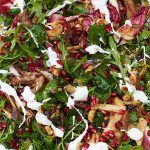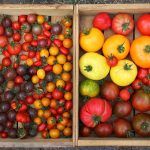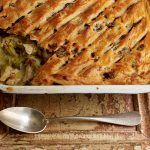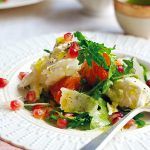Well, the forecasters say that a white Christmas looks unlikely this year, down here at least, and that it won’t even be that chilly either. The photograph, taken last January, is just wishful thinking. Gardens benefit from a good bit of cold each year, to kill off pests and to stop weeds from growing. Many crops – hardy fruit such as apples and pears amongst them – actually need cold weather to induce proper dormancy so that they flower well when they have woken up again in spring. The technical term is vernalization. Garlic requires cold too and I’ve always had more success planting in autumn than late winter.
I am cooking Christmas dinner this time and, whilst I’d love to say that all the vegetables will come from my allotment, I’d be fibbing. Some will at least, but it is possible to do the whole lot with a bit of forward planning. I did it once and felt very proud. If you’re that way inclined, here’s what you’d have to do…
Many of the possible accompaniments to the traditional roast are harvestable now but others peaked earlier on and some forward planning is needed to have them on the day. Parsnips and leeks are in the former camp. They’ll shrug off hard frosts with no ill-effects. It’s annoying, however, if a cold snap freezes them into the ground, so if this looks likely, dig what you need up in advance and heel them in somewhere a little warmer, like a bed next to the house, a greenhouse border or even a bucket of potting compost in a cool porch. In this situation, Jerusalem artichokes should receive the bucket treatment too.
Carrots and beetroot can stand some frost but once into November, carrots in particular start getting slug-mangled. Lift them and store in boxes of sand or compost somewhere well ventilated, dry, cool (but frost free) and safe from vermin, such as a garage, conservatory or shed. Twist off the leaves and arrange in layers with the bigger ones towards the bottom (they keep longer) but don’t let them touch, or else any rot will spread more easily. For this reason, don’t store damaged produce and check regularly for signs of decay. They should last till March or even beyond. Celeriac, swedes and turnips can also be kept in this way.
The garlic, onions and shallots harvested in the summer are best hung up in nets or plaits or laid in slatted trays. Squash keep for months just as they are and are decorative too. Maincrop potatoes are lifted in September and early October and after drying for a few hours are put in wooden crates, or in sacks made of paper or hessian. They must be kept in the dark or they will turn green and poisonous. Robust greens like Brussels sprouts, kale and Savoy cabbage can be picked on Christmas morning itself. Their flavour actually improves after a few sharp frosts.
I think it’s really impressive what can be done without recourse to fridges and airfreight and we haven’t even touched on the business of making jams, jellies and chutneys. Anyway, whatever you are eating this Christmas, have a good one.























